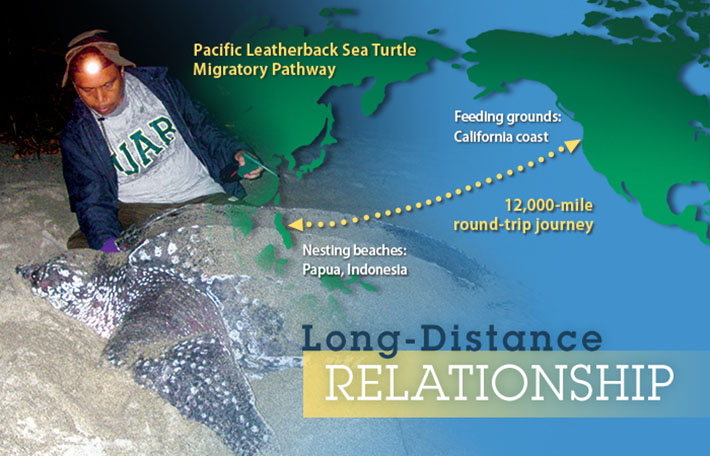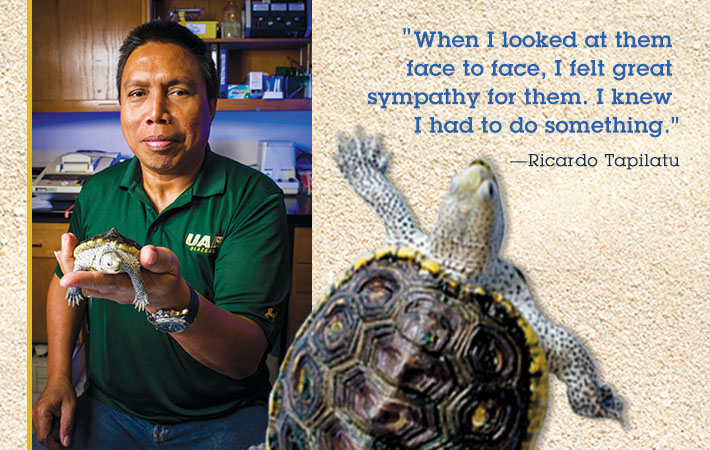
Ricardo Tapilatu: Graduate Student, UAB Department of Biology
By Susannah FeltsThe Pacific leatherback sea turtle, the largest of all living turtles, has great cultural and biological significance in Ricardo Tapilatu’s homeland of West Papua, Indonesia, but their numbers have been in decline for decades.
Tapilatu first saw the turtles’ eggs as a high school senior; years later he was able to visit the turtles’ last nesting stronghold, on two isolated beaches in West Papua. “When I looked at them face to face, I felt great sympathy for them,” he says. “I knew I had to do something.”
Ever since, Tapilatu dedicated his education and career to conservation of the endangered leatherback. His efforts at the State University of Papua convinced him that “my conservation skills and knowledge about sea turtles were limited,” he says. So he applied for a Fulbright grant and made the trip around the world to study at UAB with biology professor and turtle expert Thane Wibbels, Ph.D.
Tapilatu’s research at UAB has demonstrated that the Pacific leatherback sea turtle population has declined 78 percent in the past 30 years. While nesting, the turtles are at high risk for egg poaching and from predators such as wild pigs and dogs, among other threats. During their seven-month, transpacific odyssey from their Indonesian nesting grounds to the California coast, the turtles face the threat of becoming trapped in nets and caught on long-line fishing gear. This migration takes leatherbacks through the waters of no fewer than 22 different fishing nations before they reach the California coast, which is rich with jellyfish, their meal of choice and impetus for the nearly 12,000-mile round-trip journey.
Consequently, any effort at protecting and increasing the turtles’ numbers requires extensive international partnerships, Tapilatu says. To that end, in October 2013 he helped organize the first leatherback sea turtle conservation summit between Indonesia and California, the two locations most critical to the turtles’ life cycle. The summit, held in Monterey, California, brought together dignitaries from both sides of the Pacific who signed a declaration agreeing to work together to protect the leatherback, Tapilatu says.
Now, Tapilatu’s focus will be on “management strategy” in the turtles’ Indonesian nesting grounds. In particular, he and his team of researchers in Indonesia are looking at ways “to ensure that a large number of hatchlings get into the water—addressing threats on the beaches so that they won’t be a problem,” Tapilatu says. He’s in the fight for the long haul: Clear results of these efforts won’t be seen for 15 to 20 years. “We have to monitor the population and see if our solutions to threats are working,” Tapilatu says. He’ll continue monitoring how many females successfully return to the nesting grounds each year.
“It is a tremendously unique turtle,” he says. “It’s definitely one you don’t want to lose.”
 Ricardo Tapilatu (above in Thane Wibbels's UAB lab; at top on a nesting beach in Indonesia) is helping to save the Pacific leatherback sea turtle.
Ricardo Tapilatu (above in Thane Wibbels's UAB lab; at top on a nesting beach in Indonesia) is helping to save the Pacific leatherback sea turtle.Get Involved
• Learn about UAB's academic programs in biology.
• Give something and change everything for students in the UAB Department of Biology.